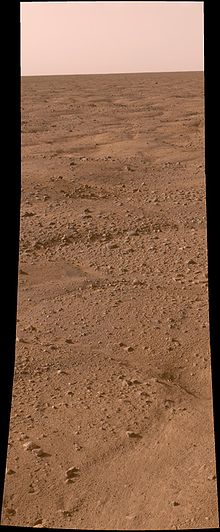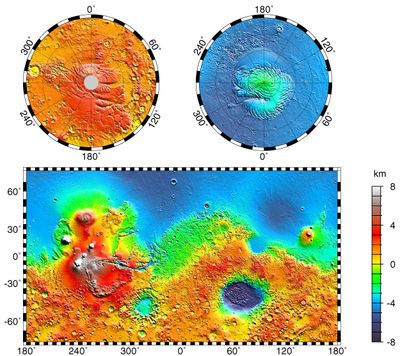- Vastitas Borealis
-
Vastitas Borealis (Latin, 'northern waste' [1]) is the largest lowland region of Mars. It is in the northerly latitudes of the planet and encircles the northern polar region. Vastitas Borealis is often simply referred to as the Northern plains or Northern lowlands of Mars. The plains lie 4–5 km below the mean radius of the planet. To the north lies Planum Boreum.
The region was named by Eugene Antoniadi, who noted the distinct albedo feature of the Northern plains in his book La Planète Mars (1930). The name was officially adopted by the International Astronomical Union in 1973.[2]
Two distinct basins are recognized within the Vastitas Borealis: the North Polar Basin and Utopia Planitia. Some scientists have speculated the plains were covered by an ocean at some point in Mars' history and putative shorelines have been suggested for its southern edges. Today these mildly sloping plains are marked by ridges, low hills, and sparse cratering. Vastitas Borealis is noticeably smoother than similar topographical areas in the south.
In 2005 the European Space Agency's Mars Express spacecraft imaged a substantial quantity of water ice in a crater in the Vastitas Borealis region. The environmental conditions at the locality of this feature are suitable for water ice to remain stable. It was revealed after overlaying frozen carbon dioxide sublimated away at the commencement of the Northern Hemisphere Summer and is believed to be stable throughout the Martian year.[3]
 The plains of Vastitas Borealis, photographed by NASA's Phoenix lander in 2008. Cryoturbation polygons caused by the Martian permafrost are visible.
The plains of Vastitas Borealis, photographed by NASA's Phoenix lander in 2008. Cryoturbation polygons caused by the Martian permafrost are visible.
A NASA probe named Phoenix landed safely in a region of Vastitas Borealis unofficially named Green Valley on May 25, 2008 (in the early Martian summer). Phoenix landed at 68.218830°N 234.250778°E.[4] The probe, which will remain stationary, collected and analyzed soil samples in an effort to detect water and determine how hospitable the planet might once have been for life to grow. It remained active there until winter conditions became too harsh around five months later.[5]
References
- ^ Charlton T. Lewis, Charles Short, A Latin Dictionary, Oxford. Clarendon Press. 1879. ISBN 0198642016 [1]
- ^ USGS Planetary Nomenclature (click on the feature name for details)
- ^ "Water ice in crater at Martian north pole". European Space Agency. http://www.esa.int/SPECIALS/Mars_Express/SEMGKA808BE_0.html. Retrieved 2007-08-04.
- ^ Lakdawalla, Emily (2008-05-27). "Phoenix Sol 2 press conference, in a nutshell". The Planetary Society weblog. Planetary Society. http://planetary.org/blog/article/00001470/. Retrieved 2008-06-04.
- ^ "Mars lander aims for touchdown in 'Green Valley'". New Scientist Space. http://space.newscientist.com/article/dn13661-mars-lander-aims-for-touchdown-in-green-valley.html. Retrieved 2008-04-14.
External links
- Martel, L.M.V. (July, 2003) Ancient Floodwaters and Seas on Mars. Planetary Science Research Discoveries. http://www.psrd.hawaii.edu/July03/MartianSea.html
Mars Areography General- Observation history
- Albedo features (Solis Lacus)
- Atmosphere
- Canals (list)
- Climate
- Color
- Water
- Glaciers
- Life
- North Polar Basin
- Chaos terrain
- Noachian
- Soil
Regions- Alba Mons
- Albor Tholus
- Arsia Mons
- Ascraeus Mons
- Biblis Tholus
- Elysium Mons
- Hecates Tholus
- Olympus Mons
- Pavonis Mons
- Syrtis Major Planum
- Tharsis
- Tharsis Montes
- North Polar Basin
- Hellas Planitia
- Argyre Planitia
- Schiaparelli
- Gusev
- Eberswalde
- Bonneville
- Eagle
- Endeavour
- Endurance
- Erebus
- Victoria
- Gale
- Galle
- Ibragimov
- Santa Maria
- Valles
- Chasmata
- Outflow channel
- Valles Marineris
Moons Specific- Phobos
- (Features
- Stickney crater
- Monolith)
- Deimos
- (Features)
CommonExploration Past and
CurrentFutureAstronomy EclipsesAsteroidsMeteorites Other topics - Darian calendar
- Timekeeping on Mars
- Flag of Mars
- In Fiction
- Martian
- Mars Society
- (FMARS
- MDRS)
- Mars Institute
- (Haughton–Mars Project)
- Mythology
- Ocean Hypothesis
Categories:- Plains on Mars
- Mare Boreum quadrangle
- Mars stubs
- Astrogeology stubs
Wikimedia Foundation. 2010.


